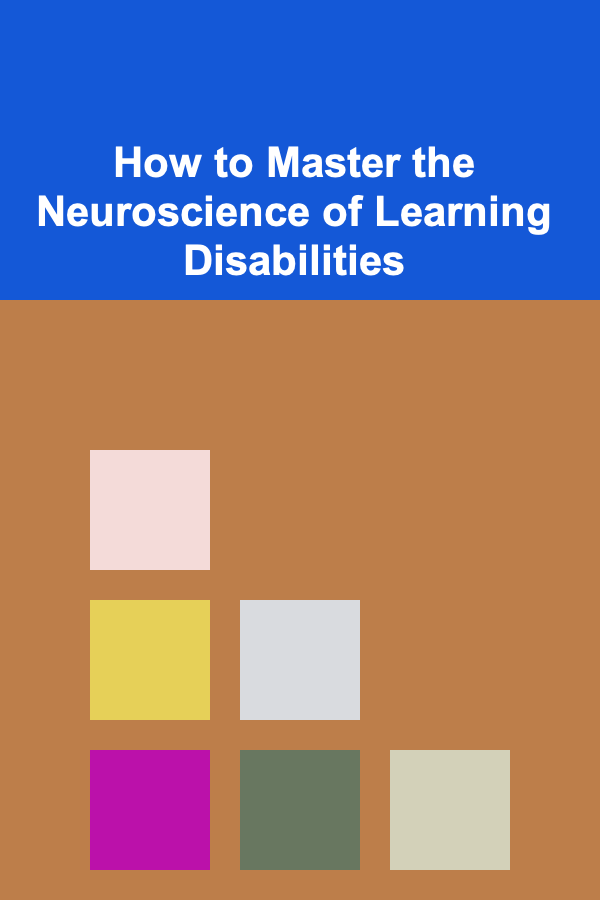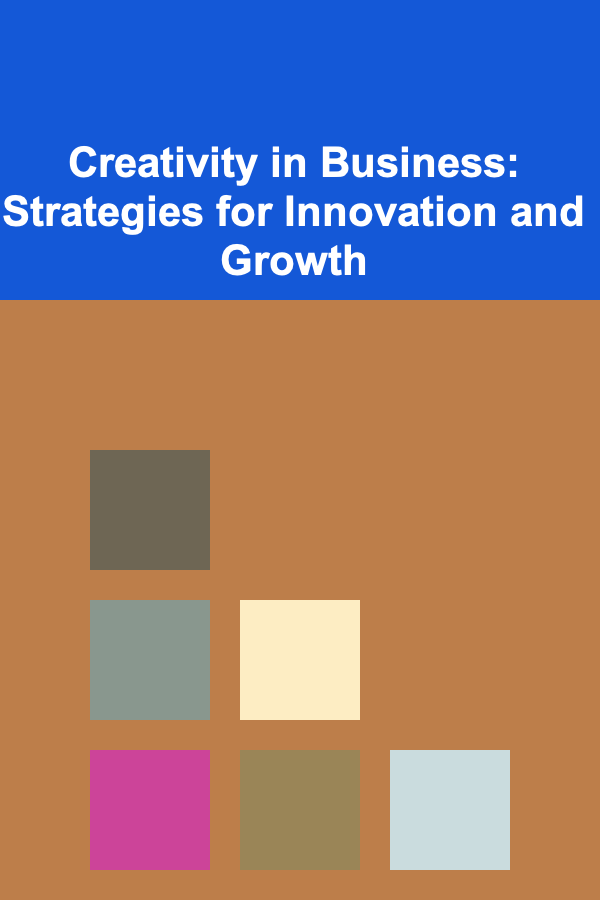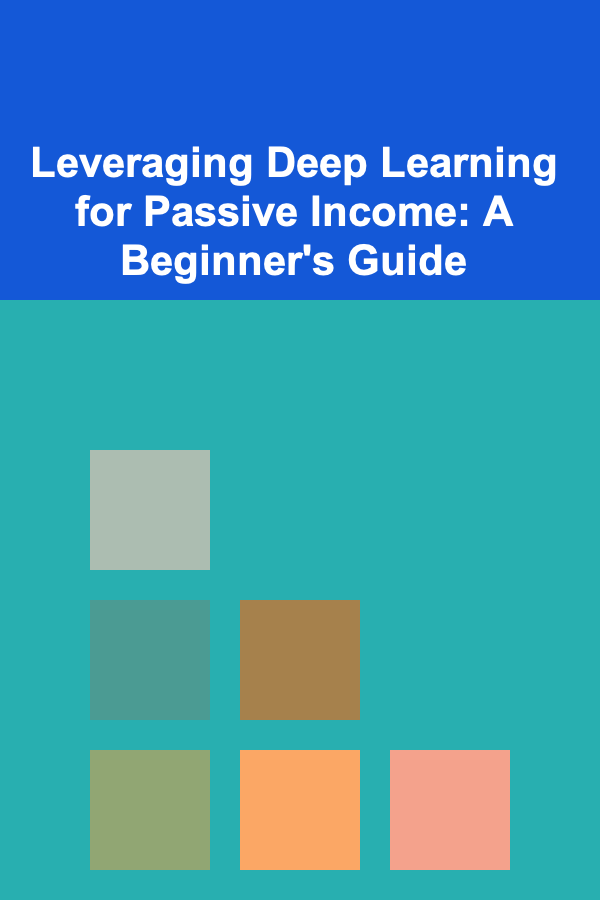
How to Master the Neuroscience of Learning Disabilities
ebook include PDF & Audio bundle (Micro Guide)
$12.99$7.99
Limited Time Offer! Order within the next:

Learning disabilities (LDs) are a set of cognitive conditions that affect the brain's ability to process, store, or retrieve information. These disorders can make it difficult for individuals to learn in conventional ways, often affecting skills such as reading, writing, mathematics, and more. The field of neuroscience has made significant strides in understanding the underlying mechanisms of learning disabilities, offering insights into how these conditions develop and how they can be addressed. This article will explore how the latest neuroscience research can help us better understand learning disabilities and the strategies that can be used to manage and support individuals with these challenges.
Understanding Learning Disabilities: The Neuroscientific Perspective
Learning disabilities are often defined by the difficulty a person faces in specific areas of learning, such as dyslexia (reading), dyscalculia (math), or dysgraphia (writing). These challenges are not due to a lack of intelligence, motivation, or effort, but instead are the result of neurological differences in the brain's structure and function.
Brain Regions Involved in Learning
Research indicates that different types of learning disabilities are associated with dysfunction in specific areas of the brain. For example:
- Dyslexia is typically linked to abnormalities in the left hemisphere of the brain, particularly in areas such as the phonological loop of the working memory, which is involved in processing sound and language. The angular gyrus and temporal lobe have also been implicated in reading and phonological processing difficulties.
- Dyscalculia , or difficulties with math, often involves areas of the brain like the intraparietal sulcus, which is responsible for number processing and arithmetic functions. Disruptions in this area can hinder an individual's ability to comprehend numbers and solve math problems effectively.
- Dysgraphia , which affects writing, is often linked to problems in the frontal lortex , an area responsible for motor skills, planning, and execution, as well as the parietal lobe, involved in processing sensory input and forming written language.
These areas of dysfunction suggest that learning disabilities are not simply a matter of lack of effort or motivation, but rather reflect underlying neurological differences that can make specific cognitive tasks more challenging.
The Neuroscience of Learning: How the Brain Learns and Retains Information
Understanding how the brain learns and retains information is crucial for mastering the neuroscience of learning disabilities. The process of learning involves complex interactions between neurons, brain regions, and neural pathways, often referred to as neuroplasticity.
Neuroplasticity: The Brain's Ability to Change
Neuroplasticity is the brain's remarkable ability to reorganize itself by forming new neural connections throughout life. This is especially important when addressing learning disabilities, as it shows that the brain is capable of adapting and compensating for areas of dysfunction.
For individuals with learning disabilities, certain neural pathways may not function optimally, which can make learning more difficult. However, neuroplasticity suggests that with the right interventions, the brain can form new pathways or strengthen existing ones to improve learning outcomes.
Working Memory and Attention
Two critical components of learning are working memory and attention. Working memory refers to the brain's ability to hold and manipulate information over short periods, while attention determines the brain's ability to focus on relevant information and ignore distractions.
In individuals with learning disabilities, these processes may be impaired. For instance, people with dyslexia often struggle with working memory, particularly when it comes to retaining and processing language-based information. On the other hand, individuals with attention-deficit disorders (often co-occurring with learning disabilities) may have difficulty concentrating and retaining information long enough to learn effectively.
The Role of Sleep in Learning
Sleep plays a critical role in memory consolidation, the process by which the brain strengthens and stores information. Studies have shown that individuals with learning disabilities often experience disrupted sleep patterns, which can further hinder learning. Poor sleep can negatively impact cognitive function, including memory, attention, and problem-solving skills.
Thus, understanding the role of sleep in learning is vital when addressing learning disabilities. Strategies to improve sleep hygiene, such as establishing consistent sleep schedules, reducing screen time before bed, and ensuring a quiet and comfortable sleep environment, can be beneficial for individuals with LDs.
The Impact of Genetics on Learning Disabilities
Research has shown that learning disabilities can have a genetic component. Family studies suggest that if one sibling has a learning disability, there is a higher chance that other siblings may also have similar difficulties. Genetic studies have identified certain genes associated with language processing, attention, and motor skills that may contribute to learning disabilities.
However, while genetics may predispose individuals to certain learning challenges, environmental factors also play a significant role in the development of these disabilities. For example, a child's exposure to a language-rich environment can help mitigate some of the effects of dyslexia, while early intervention and support can significantly improve learning outcomes.
Strategies to Manage Learning Disabilities: Leveraging Neuroscience for Effective Intervention
Understanding the neuroscience of learning disabilities has led to the development of a variety of intervention strategies that can help individuals with LDs overcome their challenges. These strategies are grounded in principles of neuroplasticity, cognitive science, and brain-based learning.
Early Intervention
Research indicates that early intervention is critical in addressing learning disabilities. The earlier an individual receives support, the better their chances are for developing compensatory strategies and strengthening neural pathways that may be underdeveloped. Early intervention programs often focus on targeted exercises to improve working memory, phonological awareness, and other cognitive functions.
Cognitive Training Programs
Cognitive training programs are designed to target specific cognitive weaknesses in individuals with learning disabilities. These programs use computer-based exercises to enhance memory, attention, processing speed, and other cognitive skills. By repeatedly engaging the brain in these targeted tasks, individuals can strengthen neural connections and improve learning abilities.
One such program is Cogmed, which focuses on improving working memory for children with attention and learning difficulties. Research has shown that these types of cognitive training programs can lead to measurable improvements in academic performance and daily functioning.
Multisensory Learning Approaches
Multisensory learning approaches involve engaging more than one sense at a time to enhance learning. For example, individuals with dyslexia can benefit from seeing, hearing, and physically interacting with words or concepts to reinforce learning. This approach targets different brain regions simultaneously, providing a richer and more effective learning experience.
Orton-Gillingham is one such approach used to teach children with dyslexia to read. It combines visual, auditory, and kinesthetic techniques, helping students process and retain information through multiple sensory pathways.
Brain-Based Learning Environments
Creating a brain-based learning environment is another crucial strategy. Research in neuroscience suggests that the learning environment can significantly affect how the brain processes and retains information. A well-structured, predictable environment with minimal distractions can help individuals with learning disabilities focus better and absorb information more effectively.
Teachers and educators can use brain-based learning techniques such as providing clear instructions, breaking tasks into smaller, manageable steps, and offering plenty of positive reinforcement to create a more supportive learning environment for students with LDs.
Use of Technology and Assistive Tools
Technology has become an invaluable tool in the management of learning disabilities. Assistive technologies such as text-to-speech software, speech-to-text programs, and organizational apps can help individuals with LDs overcome barriers to learning. For example, students with dyslexia can use text-to-speech tools to read written material, while those with dysgraphia can use voice recognition software to dictate their thoughts.
Other assistive technologies, such as digital organizers and task management apps, can also help individuals with attention difficulties stay on task and keep track of assignments.
Social and Emotional Support
Learning disabilities can take a toll on an individual's self-esteem, especially when they struggle to meet academic expectations. Providing emotional and social support is essential in helping individuals with LDs navigate the challenges they face. This includes offering encouragement, helping students set realistic goals, and creating a safe space where they feel understood and supported.
Therapeutic interventions, such as cognitive-behavioral therapy (CBT), can also help individuals with learning disabilities develop coping strategies for dealing with anxiety, frustration, and low self-esteem. This type of therapy focuses on changing negative thought patterns and behaviors, helping individuals build resilience and improve their emotional well-being.
The Future of Learning Disabilities: Neuroscience and Beyond
The field of neuroscience holds great promise for understanding and managing learning disabilities. With advancements in neuroimaging techniques and genetic research, we are gaining a deeper understanding of the brain's role in learning. This knowledge will continue to inform new approaches to intervention, making it possible for individuals with learning disabilities to reach their full potential.
In the future, personalized interventions based on brain scans and genetic testing may become more common, allowing for tailored treatment plans that address the specific needs of each individual. Additionally, the development of more sophisticated cognitive training programs and assistive technologies will continue to improve the quality of life for individuals with learning disabilities.
Conclusion
Mastering the neuroscience of learning disabilities involves understanding the complex ways in which the brain processes, stores, and retrieves information. While learning disabilities present significant challenges, they are not insurmountable. With early intervention, targeted cognitive training, and brain-based learning strategies, individuals with learning disabilities can thrive.
By harnessing the power of neuroscience, we can better support those with LDs, enabling them to overcome their challenges and achieve success in school and beyond. As our understanding of the brain continues to evolve, we can look forward to even more effective interventions and a brighter future for individuals with learning disabilities.

Creativity in Business: Strategies for Innovation and Growth
Read More
How to Organize Your Garage for Different Seasonal Activities
Read More
How to Save Money on Household Expenses Without Sacrificing Quality
Read More
How to Select Energy-Efficient Bulbs That Save You Money
Read More
How to Use Dollar-Cost Averaging to Your Advantage
Read More
Leveraging Deep Learning for Passive Income: A Beginner's Guide
Read MoreOther Products

Creativity in Business: Strategies for Innovation and Growth
Read More
How to Organize Your Garage for Different Seasonal Activities
Read More
How to Save Money on Household Expenses Without Sacrificing Quality
Read More
How to Select Energy-Efficient Bulbs That Save You Money
Read More
How to Use Dollar-Cost Averaging to Your Advantage
Read More